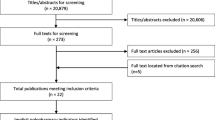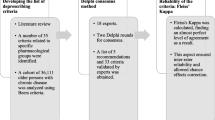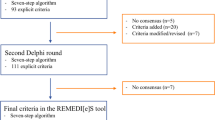Abstract
Objective
To evaluate the inter-group and intra-group reliability of a modified Medication Appropriateness Index (MAI) for use in primary care.
Methods
Elderly (>65 years) polypharmacy (≥5 drugs) patients in Copenhagen County participated in the study. Information concerning their medical history and information regarding each drug taken by them was provided by their own general practitioners. A MAI was scored by two groups of evaluators for every drug. To evaluate inter-group agreement, 211 drugs taken by 30 patients were rated according to the ten criteria making up the MAI. Both evaluator groups provided summaries of comments on the medication of each patient. Intra-group agreement was determined from MAI ratings performed twice at two different times on 86 drugs taken by ten patients. Agreement and chance-adjusted agreement were determined, the latter through kappa statistics. The proportion of positive (ppos) and negative (pneg) agreement was also determined.
Results
The overall chance-adjusted inter-group agreement (kappa) was moderate. The agreement was good on the criteria practical directions and drug–disease interaction, moderate on the criteria dosage and duration, fair on the criteria indication, effectiveness, duplication and expense, and poor on the criterion drug–drug interaction. The overall chance-adjusted intra-group agreement was good for all criteria and very good for the criteria indication and practical directions.
Conclusion
The MAI is used to quantify appropriate and inappropriate prescribing and changes in prescribing quality in intervention studies. However, caution should be used when comparing results across different settings and evaluators. Our study suggests that the index should only be used in intervention studies if the same group rates the appropriateness pre- and post-intervention.
Similar content being viewed by others
References
Buetow SA, Sibbald B, Cantrill JA, Halliwell S (1996) Prevalence of potentially inappropriate long term prescribing in general practice in the United Kingdom, 1980–1995 systematic literature review. BMJ 313:1371–1374
Curtis LH, Ostbye T, Sendersky V, Hutchison S, Dans PE, Wright A et al (2004) Inappropriate prescribing for elderly Americans in a large outpatient population. Arch Intern Med 164:1621–1625
Goulding MR (2004) Inappropriate medication prescribing for elderly ambulatory care patients. Arch Intern Med 164:305–312
Gurwitz JH, Field TS, Avorn J, McCormick D, Jain S, Eckler M et al (2000) Incidence and preventability of adverse drug events in nursing homes. Am J Med 109:87–94
Zhan C, Sangl J, Bierman AS, Miller MR, Friedman B, Wickizer SW et al (2001) Potentially inappropriate medication use in the community-dwelling elderly: findings from the 1996 Medical Expenditure Panel Survey. JAMA 286:2823–2829
Hallas J, Gram LF, Grodum E, Damsbo N, Brosen K, Haghfelt T et al (1992) Drug related admissions to medical wards: a population based survey. Br J Clin Pharmacol 33:61–68
Schneeweiss S, Hasford J, Gottler M, Hoffmann A, Riethling AK, Avorn J (2002) Admissions caused by adverse drug events to internal medicine and emergency departments in hospitals: a longitudinal population-based study. Eur J Clin Pharmacol 58:285–291
Fitzgerald LS, Hanlon JT, Shelton PS, Landsman PB, Schmader KE, Pulliam CC et al (1997) Reliability of a modified medication appropriateness index in ambulatory older persons. Ann Pharmacother 31:543–548
Hanlon JT, Schmader KE, Samsa GP, Weinberger M, Uttech KM, Lewis IK et al (1992) A method for assessing drug therapy appropriateness. J Clin Epidemiol 45:1045–1051
Fitzgerald LS, Hanlon JT, Shelton PS, Landsman PB, Schmader KE, Pulliam CC et al (1997) Reliability of a modified medication appropriateness index in ambulatory older persons. Ann Pharmacother 31:543–548
Hanlon JT, Schmader KE, Samsa GP, Weinberger M, Uttech KM, Lewis IK et al (1992) A method for assessing drug therapy appropriateness. J Clin Epidemiol 45:1045–1051
Kassam R, Martin LG, Farris KB (2003) Reliability of a modified medication appropriateness index in community pharmacies. Ann Pharmacother 37:40–46
Fitzgerald LS, Hanlon JT, Shelton PS, Landsman PB, Schmader KE, Pulliam CC et al (1997) Reliability of a modified medication appropriateness index in ambulatory older persons. Ann Pharmacother 31:543–548
Hanlon JT, Schmader KE, Samsa GP, Weinberger M, Uttech KM, Lewis IK et al (1992) A method for assessing drug therapy appropriateness. J Clin Epidemiol 45:1045–1051
Fitzgerald LS, Hanlon JT, Shelton PS, Landsman PB, Schmader KE, Pulliam CC et al (1997) Reliability of a modified medication appropriateness index in ambulatory older persons. Ann Pharmacother 31:543–548
Hanlon JT, Schmader KE, Samsa GP, Weinberger M, Uttech KM, Lewis IK et al (1992) A method for assessing drug therapy appropriateness. J Clin Epidemiol 45:1045–1051
Cicchetti DV, Feinstein AR (1990) High agreement but low kappa: II. Resolving the paradoxes. J Clin Epidemiol 43:551–558
Feinstein AR, Cicchetti DV (1990) High agreement but low kappa: I. The problems of two paradoxes. J Clin Epidemiol 43:543–549
Fitzgerald LS, Hanlon JT, Shelton PS, Landsman PB, Schmader KE, Pulliam CC et al (1997) Reliability of a modified medication appropriateness index in ambulatory older persons. Ann Pharmacother 31:543–548
Hanlon JT, Schmader KE, Samsa GP, Weinberger M, Uttech KM, Lewis IK et al (1992) A method for assessing drug therapy appropriateness. J Clin Epidemiol 45:1045–1051
Acknowledgements
This study was financially supported by the Hørslev Foundation, The Danish Research Foundation for General Practice, The Health Insurance Foundation and the Copenhagen County Health Administration.
Author information
Authors and Affiliations
Corresponding author
Rights and permissions
About this article
Cite this article
Bregnhøj, L., Thirstrup, S., Kristensen, M.B. et al. Reliability of a modified medication appropriateness index in primary care. Eur J Clin Pharmacol 61, 769–773 (2005). https://doi.org/10.1007/s00228-005-0963-0
Received:
Accepted:
Published:
Issue Date:
DOI: https://doi.org/10.1007/s00228-005-0963-0




